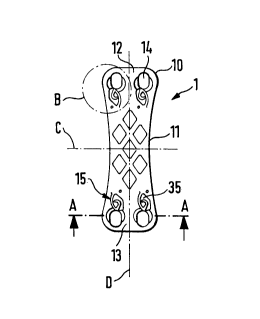Note: Claims are shown in the official language in which they were submitted.
Claims
1. Stabilizer device, in particular for stabilizing the spinal
column, comprising a stabilizer plate (1) having a first end
(12) and a second end (13) opposite to the first end and at
least one respective hole (14) at each end for receiving bone
screws (2), the bone screws having a threaded shaft (21) for
screwing in a first rotating direction and unscrewing a second
rotating direction, characterized in that a device (15, 23) for
locking the bone screws against unintentional rotation in the
second rotating direction is provided.
2. Stabilizer device according to claim 1,
characterized in that the locking device (15) comprises a
resilient member (30, 31, 32) engaging the bone screw to be
received.
3. Stabilizer device according to claim 2,
characterized in that the bone screw (2) comprises a screw head
(20) being adjacent to the threaded shaft (21) and comprising,
at the periphery thereof, a toothing (23) engaging the resilient
member for providing the lock.
4. Stabilizer device according to claim 3,
characterized in that the toothing (23) is formed in such a
manner that a first tooth flank (51) points in radial direction
of the screw head (20) and a second tooth flank (52) is formed
including an acute angle with this radial direction, and that
the second tooth flank precedes the first tooth flank in the
sense of the first rotating direction.
5. Stabilizer device according to claim 3 or 4,
characterized in that the hole (14) is formed as an elongate
hole having a longitudinal axis pointing at the two ends (12,
13) of the plate, the elongate hole being superimposed by a
circular hole having the same diameter and a countersink (16)
for fittingly receiving the screw head (20), whereby the center
(M) of the circular hole is located on the longitudinal axis of
the elongate hole and offset from the center of the elongate
hole towards the opposite end of the plate.
6. Stabilizer device according to any of the claims 2 to 5,
characterized in that the resilient member (30, 31, 32) is
formed as a portion of the stabilizer plate (1) lying in the
plane of the plate.
7. Stabilizer device according to claim 6,
characterized in that the resilient member has a curved web
portion (30) connected with the stabilizer plate (1) and a
straight web portion (31) joined thereto on the side of the
center of curvature and including an acute angle with the curved
web portion, the straight web portion having a free end which is
bent towards the curved web portion, the curvature of the curved
web portion (30) being a left-hand curvature when seen from the
point of connection with the stabilizer plate.
8. Stabilizer device according to claim 6 or 7,
characterized in that the resilient member can be deflected in a
recess (35) of the stabilizer plate (1) in direction of the
center of curvature of the curved web portion (30).
9. Stabilizer device according to claim 8,
characterized in that the resilient member is formed so that a
tip (17) formed between the curved web portion (30) and the
straight web portion has, in unstressed state of the resilient
member, a distance from the center of the circular hole which is
smaller than the radius of the circular hole.
10. Stabilizer device according to claim 8 or 9,
characterized in that the resilient member is formed so that the
tip (17) thereof is, in a deflected position of the resilient
member, in a distance from the center of the circular hole which
is larger than or equal to the outer radius of the countersink
(16) surrounding the circular hole.
11. Stabilizer device according to any of the claims 3 to 10,
characterized in that the head (20) of the bone screw (2)
comprises an edge having the shape of a substantially spherical
segment, whereby the center of the spherical segment is on the
side opposite to the threaded shaft (21).
12. Stabilizer plate according to claim 11,
characterized in that the countersink (16) of the circular hole
is adapted to match the shape of the screw head (20).
13. Stabilizer device according to any of the claims 1 to 12,
characterized in that two holes (14) are provided at each of the
first (12) and second (13) end of the stabilizer plate (1).
14. Stabilizer device according to any of the claims 1 to 13,
characterized in that the stabilizer plate (1) together with the
lock device (15) and the bone screw (2) are made of a physically
friendly metal, preferably titanium.
15. Stabilizer device according to any of the claims 3 to 14,
characterized in that the bone screw (2) has a recess (55) for
inserting a wrench for rotating the screw, the recess being
provided at the end of the screw head (20) opposite to the
threaded shaft.
